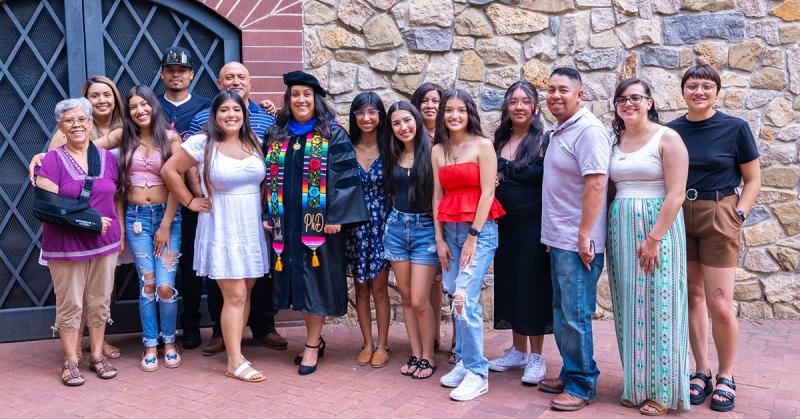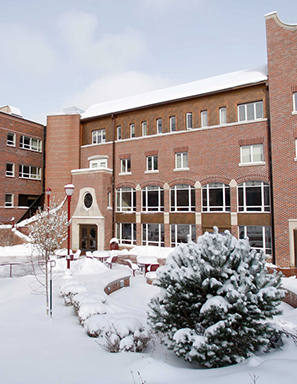Exploring Chicana Adolescent Suicide
Recent PhD graduate Xochilt Alamillo studies mental health and suicidality among Latinx youth

Education and issues around identity have shaped alumna Xochilt Alamillo’s trajectory, from her early years in Compton during the 1980s and early 1990s to her graduation this year with a doctorate from the University of Denver (DU) Graduate School of Social Work (GSSW).
The child of Mexican immigrants, Alamillo (MSW ’16, PhD ’24, LCSW) says that in Compton, “Our schools were very poor. There were no books. We just had paper and pencils. We didn’t have to carry backpacks because there was nothing to put in them.” Still, she says that she “shined” in school. “School was a place where I could do my best and get rewarded, and I wanted to make my immigrant parents proud.”
Following the 1992 Los Angeles riots, Alamillo’s family moved to the Denver area, where her father had friends. Alamillo was 12 at the time. She recalls that the move was a culture shock. “I was now a minority. That was not the reality in Compton — we were all Black and Brown, all the teachers were Black or Brown. [In Denver] I struggled around identity and not belonging.”
The student who had once shined now had difficulty keeping up with academics. Barely making it through high school, she married young and started a family.
After she had her last child in her mid 20s, Alamillo earned an associate’s degree from a local community college and worked in real estate, which turned out to be an unfulfilling career choice. Thus, she enrolled in Metropolitan State University of Denver (MSU Denver) with plans to become a therapist. Her first class there was a clinical theory course taught by human services Professor Antonio Ledesma, who holds a PhD in human communication from DU. That encounter changed Alamillo’s life.
“I’d never met a Latino/a who was a doctor,” recalls Alamillo, who was 31 at the time. “When that class was over, I went to him and asked, ‘How do I do what you do?’” He explained the PhD process and advised Alamillo to get an MSW. “I said, ‘OK, that’s what I’ll do then!’”
When Alamillo started her MSW program at GSSW, she says she knew right away that social work was the right fit. She recalls, “They were explaining social justice, all the things I’d experienced around identity, violence in Compton, school — all the things that make up social work that are so much more than psychology and mental health. That’s how I knew I wanted a PhD. That culture shock after the move was significant; it had a big impact on my life. I wanted to help with that issue, which is why my research is around Latinx youth mental health.”
Alamillo’s doctoral dissertation, “Ni de Aqui, Ni de Alla: Exploring the Role of Biculturalism, Cultural Values & Caregiver–Adolescent Conflict in Chicana Adolescent Suicide” explored the urgent public health problem of suicidal ideation and attempts among Chicana adolescents.
Alamillo explains that suicide among Latinx youth has been a problem for generations. She focused her research on Latina youth because for more than a decade, young Latinas had the highest rate of attempted suicide, with 1 in 4 attempting to end their lives. But despite the prevalence, Alamillo says, there has been little research into Latina suicidality, and what there is tends to “lump us into a monolith” and doesn’t explore potential differences by nationality, for instance. She focused her research on Chicana youth (those with Mexican heritage) to shed light on what factors cause them to be more likely to attempt suicide.
For her dissertation project, Alamillo interviewed 11 adult Chicanas across the United States about their mental health experiences as youth. She found that that gender, ethnicity and cultural values all contributed to mental health. Alamillo explains, “There’s this cultural value of familismo in Latinx families, where families come first, above any individual. It’s a protective factor, but in extreme cases it can be a risk factor.” Many of Alamillo’s study participants said they felt they were treated differently because of their gender. “They felt unsupported in wanting to be individuals. They felt like being bicultural contributed to this idea that they didn’t belong — not in the U.S. because they were Chicanas and not at home because they weren’t following the Mexican cultural values their parents wanted them to. They felt like they were between two societies.”
Participants also talked about the mental health stigma in the Latinx community. For example, Alamillo says that if they asked for help, participants were dismissed or denied and “told they needed to just clean some more or go for a walk.”
Alamillo decided early in her PhD program that she didn’t want to be a full-time professor. She says, “I love working in community, for community. It’s my goal to be able to be able to do research from community rather than academia.” For now, working in community means working as a bilingual therapist in private practice. Informed by her own experiences, Alamillo applies a social justice and trauma-informed lens in her work with women and youth, taking generational trauma, historical trauma, racial trauma and the current political climate into account.
She also works as an adjunct instructor at GSSW and MSU Denver, and she contracts with public schools to offer training on trauma-informed practices with an emphasis on racial equity. Ultimately, she hopes to develop school-based programs that support the needs of youth of color.
Alamillo recalls that when she interviewed participants for her dissertation research and asked them who had provided support, “they couldn’t think of anyone.” She adds, “They mentioned school: I wish there was someone at school who saw me. They just needed one person to see them.” Participants shared fears that if they asked for help, someone would call child welfare. Or, when they were offered mental health help, it was with a White therapist — not someone who shared their identity. These are the sorts of needs she wants to meet with a program “where someone sees them and they feel they belong, and if something comes up, they know where to go — they have that adult.”
She adds, “It’s important to be able to tell youth they’re not alone, that what they’re feeling is part of the bicultural experience and that they’re not defective or unworthy. Here are some possible explanations for why my parents behave in this way. That does a lot for the youth — it gives them hope. There is a way to maintain a good connection with their parents and do what they want to do.”




